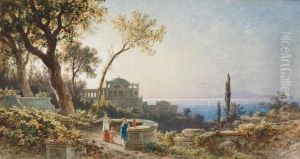Friedrich W. Albert Dressler Paintings
Friedrich Wilhelm Albert Dressler was a German artist born on December 1, 1831, in Crossen an der Oder, which was then in the Kingdom of Prussia (now Krosno Odrzańskie, Poland). He is not a widely recognized figure in art history, and as such, detailed information about his life and work is not as readily available as for some other artists. Despite this, Dressler contributed to the arts in his time, although his legacy may not have had a significant impact on subsequent generations of artists or art movements.
Dressler's artistic career unfolded during a period in which Europe was undergoing significant changes, both politically and culturally. The 19th century was marked by the rise of various art movements, including Romanticism, Realism, and Impressionism. Dressler's work, however, does not appear to be closely associated with any major movement that defined the era. Rather, his contributions may have been more localized or personal, reflecting his individual interests and the milieu in which he worked.
Little is documented about Dressler's training or his artistic influences, but it is likely that he received some formal education in the arts, as was common for artists of his time. He may have been involved in local art scenes, and his works could have included portraits, landscapes, or genre scenes, which were popular during the 19th century.
Although specific details about Dressler's oeuvre are scarce, it is known that he passed away on February 20, 1904. His death marked the end of a life spent in the pursuit of art during a transformative era for European culture. Without more substantial documentation or scholarly research, Friedrich Wilhelm Albert Dressler's full contribution to the arts remains somewhat obscure. His story is a reminder that many artists of the past, while perhaps not remembered by history, dedicated their lives to their craft and shaped the cultural landscape of their local communities.
